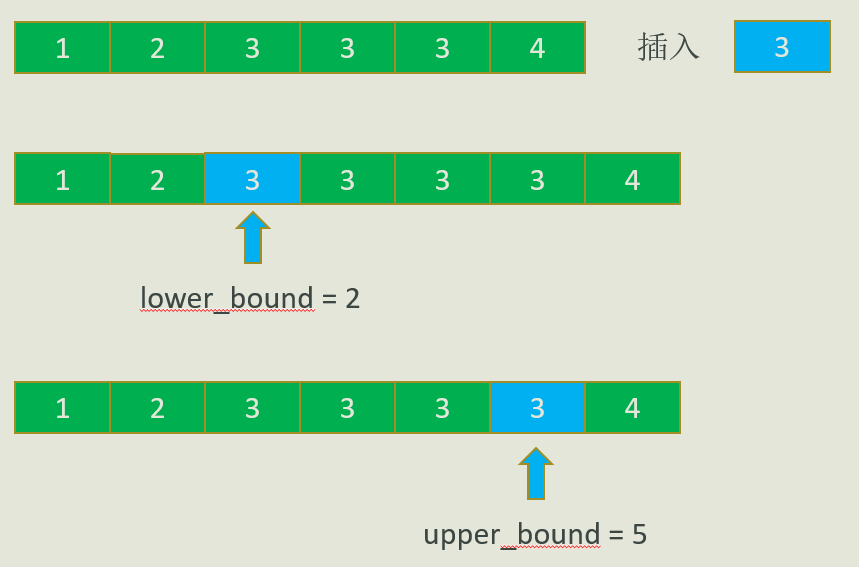C++ STL lower_bound()和upper_bound()
lower_bound()和upper_bound()用法
- lower_bound(a, a+n, x):返回数组a[0]~a[n-1]中,【大于等于】x的数中,最小的数的指针
- upper_bound(a, a+n, x):返回数组a[0]~a[n-1]中,【大于】x的数中,最小的数的指针
- lower_bound返回的是x最小的可以插入的数组位置
- upper_bound返回的是x最大的可以插入的数组位置

#include <algorithm>
#include <iostream>
using namespace std;
int main()
{
int a[] = {, , , , , , , , , };
int n = ;
for(int i = ; i < ; i ++)
{
int *lower = lower_bound(a, a+n, i);
int *upper = upper_bound(a, a+n, i);
cout << lower - a << ' ' << upper - a << endl;
}
return ;
}
/*
0 0
1 0
1 3
3 6
6 10
10 10
*/
注:lower_bound( )和upper_bound( )的前两个参数是待查范围的首尾指针(左闭右开区间,不包括尾指针)
- 前两个参数必须是vector的迭代器
- 函数的返回值也是迭代器
#include <algorithm>
#include <iostream>
using namespace std; int main()
{
int a[] = {, , , , , , , , , };
int n = ;
vector<int> b(a, a+); for(int i = ; i < ; i ++)
{
vector<int>::iterator lower = lower_bound(b.begin(), b.end(), i);
vector<int>::iterator upper = upper_bound(b.begin(), b.end(), i);
cout << lower - b.begin() << ' ' << upper - b.begin() << endl;
}
return ;
}
/*
0 0
1 0
1 3
3 6
6 10
10 10
*/
C++ STL lower_bound()和upper_bound()的更多相关文章
- [STL] lower_bound和upper_bound
STL中的每个算法都非常精妙, ForwardIter lower_bound(ForwardIter first, ForwardIter last,const _Tp& val)算法返回一 ...
- STL源码学习----lower_bound和upper_bound算法
转自:http://www.cnblogs.com/cobbliu/archive/2012/05/21/2512249.html 先贴一下自己的二分代码: #include <cstdio&g ...
- STL lower_bound upper_bound binary-search
STL中的二分查找——lower_bound .upper_bound .binary_search 二分查找很简单,原理就不说了.STL中关于二分查找的函数有三个lower_bound .upper ...
- STL中的lower_bound和upper_bound的理解
STL迭代器表述范围的时候,习惯用[a, b),所以lower_bound表示的是第一个不小于给定元素的位置 upper_bound表示的是第一个大于给定元素的位置. 譬如,值val在容器内的时候,从 ...
- STL 源码分析《5》---- lower_bound and upper_bound 详解
在 STL 库中,关于二分搜索实现了4个函数. bool binary_search (ForwardIterator beg, ForwardIterator end, const T& v ...
- STL源码学习----lower_bound和upper_bound算法[转]
STL中的每个算法都非常精妙,接下来的几天我想集中学习一下STL中的算法. ForwardIter lower_bound(ForwardIter first, ForwardIter last,co ...
- [转] STL源码学习----lower_bound和upper_bound算法
http://www.cnblogs.com/cobbliu/archive/2012/05/21/2512249.html PS: lower_bound of value 就是最后一个 < ...
- STL之std::set、std::map的lower_bound和upper_bound函数使用说明
由于在使用std::map时感觉lower_bound和upper_bound函数了解不多,这里整理并记录下相关用法及功能. STL的map.multimap.set.multiset都有三个比较特殊 ...
- STL中的二分查找——lower_bound 、upper_bound 、binary_search
STL中的二分查找函数 1.lower_bound函数 在一个非递减序列的前闭后开区间[first,last)中.进行二分查找查找某一元素val.函数lower_bound()返回大于或等于val的第 ...
随机推荐
- python全栈学习笔记(三)网络基础之网络设备及架构介绍
- 区间DP学习总结
这段时间学习了区间DP,所以试着把学到的东西稍作总结,以备不时之需. 学习区间DP首先要弄清区间DP是为了解决什么问题:一般的DP主要是特征是一次往往只操作一个数值或者存储可以不连续的物品的状态(比如 ...
- BZOJ3670:[NOI2014]动物园(KMP)
Description 近日,园长发现动物园中好吃懒做的动物越来越多了.例如企鹅,只会卖萌向游客要吃的.为了整治动物园的不良风气,让动物们凭自己的真才实学向游客要吃的,园长决定开设算法班,让动物们学习 ...
- git fetch 和 git pull 的区别
Git中从远程的分支获取最新的版本到本地有这样2个命令: 1. git fetch:相当于是从远程获取最新版本到本地,不会自动merge git fetch origin master git log ...
- DU1525 Euclid's Game 博弈
HDU1525 Euclid's Game 博弈 题意 给定两个数字 a, b. 每次只能用 较大的值 减去 较小的值的倍数, 两个人轮流进行操作, 第一个得到 0 的胜利. 分析 对于 a == b ...
- 安全过滤javascript,html,防止跨脚本攻击
本文改自: http://blog.51yip.com/php/1031.html 用户输入的东西是不可信认的,例如,用户注册,用户评论等,这样的数据,你不光要做好防sql的注入,还要防止JS的注入, ...
- Unity 游戏框架搭建 (二十一) 使用对象池时的一些细节
上篇文章使用SafeObjectPool实现了一个简单的Msg类.代码如下: class Msg : IPoolAble,IPoolType { #region IPoolAble 实现 public ...
- iOS安装CocoaPods详细过程
iOS安装CocoaPods详细过程 一.简介 什么是CocoaPods CocoaPods是OS X和iOS下的一个第三类库管理工具,通过CocoaPods工具我们可以为项目添加被称为“Pods”的 ...
- mybatis——学习笔记
配置文件 <properties resource="dbconfig.properties"></properties> 1. properties 引入 ...
- 在vue-cli + webpack 项目中使用sass
1.准备工作: 由于npm的服务器在国外,网速慢而且安装容易失败,建议在安装之前,先安装国内的镜像,比如淘宝镜像 npm install -g cnpm --registry=https://regi ...
